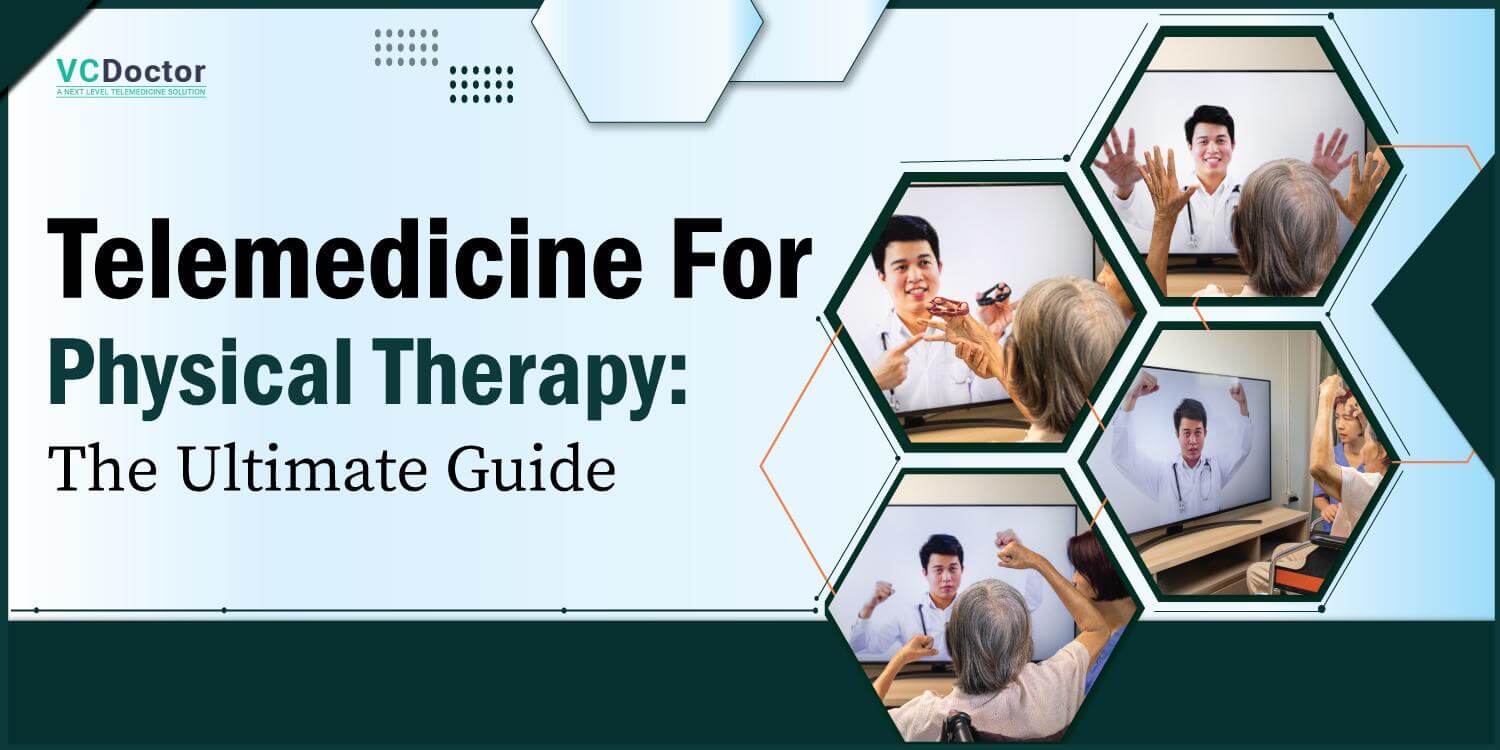Telemedicine for Physical Therapy: The Ultimate Guide
Telemedicine for physical therapy has become quite popular in recent times. But still, questions remain about its overall impact and efficacy. After all, virtual physical therapy visits have always been in-person.
But we live in the digital age where virtual doctor visits are slowly but surely becoming mainstream. So it should come as no surprise when virtual therapy visits are also seen as a natural extension of the telehealth revolution.
But is telemedicine effective for physical therapy? Is telehealth software worth it for physical therapists? Find out answers to all these and more in this blog.
Table of Contents
- What is Telehealth Physical Therapy?
- Benefits of Telehealth Physical Therapy
- Who Can Benefit from Telemedicine for Virtual Therapy?
- Virtual Physical Therapy: What to Expect
- Virtual Physical Therapy Visit: Things You Need
- Research Shows the Effectiveness of Virtual Physical Therapy
- Remote Physical Therapy Becoming More Accessible
- Telemedicine Physical Therapy Is Helping COVID-19 Patients Heal
- Making the Most of Virtual Therapy Visits
- Telemedicine for Physical Therapy: Scope Restrictions
- Summary
What is Telehealth Physical Therapy?
Virtual PT, also known as telehealth physical therapy, offers people an online alternative to follow their PT plan without going directly to the facility.
Virtual PTs are mostly one-on-one, allowing telehealth software for patients to meet physical therapists remotely. A virtual PT session needs only a laptop or personal computer and a reliable internet connection.
Benefits of Telehealth Physical Therapy
Individuals of any age who have medical issues, illnesses, or injuries that limit their daily activities can benefit from telemedicine for physical therapy.
Telehealth offers some clear advantages over traditional in-person visits:
- Accessible to more people
- Saves time and money (you cut down on travel time and costs)
- Flexible for those with busy schedules
- Prevents and mitigates COVID-19 risks
- Ideal for people with mobility challenges
Who Can Benefit from Telemedicine for Virtual Therapy?
There are different categories of people who can benefit from virtual physical therapy visits. The goals of virtual PT can include:
- Pain relief
- Avoiding surgery
- Recover from or prevent sports injuries.
- Handle age-related mobility challenges
- Diabetes and Vascular Disease Management
Virtual physical therapy visits, as previously stated, are successful and have long-term advantages for a variety of injuries and ailments, including:
- Sports injuries
- Back pain
- Burn management and treatment
- Concussion
- Multiple sclerosis
- Osteoarthritis
- Pelvic Health
- Stroke
- Spinal cord injuries
Virtual Physical Therapy: What to Expect
Your therapist will most probably suggest a HIPAA-compliant telemedicine solution. These solutions are easy to use and secure.
On the day of the session, you will visit the Telehealth physical therapy platform via app/browser, enter your credentials, and you are all set to make a virtual doctor software.
You’ll talk about your medical history, injury, pain, and/or any other problem you have. This will assist you in determining the root of your health problems.
Your therapist will next collaborate with you to create a customized treatment plan that includes exercises, information, and more. You’ll get access to videos with further information and exercise demonstrations to help you stick to your treatment plan.
Virtual Physical Therapy Visit: Things You Need
Virtual physical therapy visits are not as costly as in-person visits. You receive top-quality care without the additional effort of traveling or taking leave from work. You need only a few things to put up a Virtual Healthcare Software space. These include:
- Good internet connection
- Enough space so that your movements are not restricted.
- Excellent lighting (so that you are visible to the provider)
- A webcam that can be adjusted/tipped to better demonstrate exercises.
- A quiet corner free of any distractions and noise.
Research Shows the Effectiveness of Virtual Physical Therapy
The popularity of telemedicine platforms has skyrocketed due to their ease of use, safety, and affordability. It has proved to be a boon for people vulnerable to infections, and those who prefer the convenience of obtaining treatment at home.
During the Covid-19 pandemic, patient demand for alternative treatments rose significantly. With in-person visits restricted only to critical patients, people with physical therapy needs started looking for alternative ways.
It became clear that we would have to adapt to meet the evolving demands of patients and communities. Thankfully, we had the digital infrastructure to offer physical therapy to patients remotely and securely.
In 2016, the Journal of Bone & Joint Surgery studied 287 persons who underwent complete knee replacement surgery. This group was given remote physical therapy using 3D technology. In terms of KOOS, virtual PT was non-inferior to physical therapy. Virtual PT results were equally effective in knee extension, knee flexion, and gait speed.
Here are the findings of the study:
- Virtual physical therapy visits had lower costs than regular treatment
- Virtual PT patients had fewer rehospitalizations
- Remote physical therapy patients could optimize their time better
- Remote physical therapy patients had more flexibility in scheduling
- Remote physical therapy patients had better continuity of care
Ascenti, a UK-based PT clinic network, recently published data from over 27,000 patients, some of whom had only undergone virtual clinics software.
According to Ascenti’s data, 92 percent of virtual patients were satisfied with their results, compared to 97 percent of face-to-face patients.
Remote Physical Therapy Becoming More Accessible
There are only 6.2 physical therapists per 10,000 people across the United States. We can only imagine the state of physical therapy in other countries.
Meeting the demands of PT is difficult. Over the next decade, research suggests a glaring global shortage of therapists.
Rural communities and financially backward regions have limited access to top-quality therapists. Further, people also opt against physical therapy visits due to challenges like health insurance, budget, and rising fuel costs.
Telemedicine app breaks these barriers making physical therapy more accessible and affordable for patients.
Remote physical therapy has given health systems the flexibility to create hybrid care models. Technology-driven outpatient physical therapy has enabled scheduling flexibility, freeing up on-campus capacity for critical patients.
Telemedicine Physical Therapy Is Helping COVID-19 Patients Heal
Fatigue and weakness are likely to continue after Covid-19 infection. Physical therapy helps tremendously in post-covid recovery.
But traveling is ill-advised during COVID recovery. It exposes not only the therapist but also other non-Covid patients. This is where virtual therapy is truly exceptional.
Remote physical therapy plans can be customized and rolled out quickly. It streamlines patient rehabilitation and monitoring. While patients can access quality care easily and quickly, there is also no need for daily COVID-19 screening.
Making the Most of Virtual Therapy Visits
To get the most out of virtual physical therapy visits, you must be well-prepared. Send telemedicine helps the doctor an outline of what you want to talk about and let them choose which topic is most important to talk about first.
Check that your laptop or other equipment is working properly. Check your internet speed too. If it is slow, disconnect other devices that may be sharing the internet.
Make sure you’re dressed comfortably and have enough space to move and stretch. Don’t hesitate to ask questions if you have any doubts or confusion. Remember, the more engaged you are, the more productive will be the remote physical therapy session.
Telemedicine for Physical Therapy: Scope Restrictions
Telemedicine physical therapy offers a wide scope of services, including:
- If you are a therapist, you can use a telemedicine platform to assess your patient’s condition and mobility issues.
- If you feel the assessment is good and doesn’t necessitate in-person visits, you can then prescribe and demonstrate exercises tailored to the patient’s needs.
- Once, the patient starts the therapy sessions, you can also use virtual therapy visits to monitor their performance remotely.
- Other than this, Patients can also use telemedicine platforms to connect with therapists who are not nearby.
However, telemedicine for physical therapy also has limitations:
- It’s hard to do hands-on therapy or use fancy equipment over telemedicine.
- Patients might not have the special gear used in the VT clinic.
- Testing things like strength or flexibility can be tough without being there in person.
Despite these limitations, telemedicine for physical therapy can still provide valuable support and guidance. Especially in cases where in-person visits are impractical or inaccessible.
Don’t Let Distance Limit Your Patient’s Recovery. Explore TelePT Solutions with VCDoctor!
Summary
Post The Covid-19 pandemic, there has been a growing demand for remote healthcare solutions. Telemedicine for Physical Therapy is just one among the sea of technology-driven innovations sweeping the healthcare industry.
If you are a physical therapist who wants to offer more flexibility, more safety, and more choice to your patients then you have come to the right place. VCDoctor HIPAA-Compliant Telehealth Platform is fully customizable and comes with a slew of features that make care delivery hassle-free for providers.
VCDoctor Telehealth Platform for Physical Therapy- Advantages
- For Providers: Access patient records with ease
- For Patients: Avoid long queues with instant virtual consultations
- For Clinics: Leverage patient e-visit management
- For Startups: Kickstart your idea with a fully white-label telehealth software
You can learn more about VCDoctor Telemedicine software for providers, patients, clinics, and startups here!
FAQs
Q: How long do Telehealth physical therapy sessions last?
Routine virtual physical therapy visits last anywhere between 30-60 minutes. However, session durations may vary (either short or long) depending on individual needs.
Q: Do you offer a telemedicine platform for clinics?
Yes, we have a VCDoctor version designed specifically for clinics. The telehealth platform comes with multi-location support too- which means you add and manage multiple clinics using the same platform.
Q: I need customized telehealth platforms for physical therapy- can you help?
Yes, we can customize our telehealth platform as per your and the patient’s needs. For more details please schedule a meeting with one of our experts who will guide you about the telemedicine app features, options to customize, and more.
Q. Monitoring Progress: Therapists can track a patient’s progress over time, review exercise adherence, and make adjustments to treatment plans as needed.
Pain Management Strategies: Therapists can teach pain-relief techniques such as stretching, relaxation exercises, and modalities like heat or cold therapy.
Q: Is telemedicine for physical therapy approved by medical bodies?
Many professional organizations, including the American Physical Therapy Association (APTA), have provided guidelines and resources to support the practice of telehealth physical therapy.
Q: Can I get a demo of VCDoctor telemedicine for physical therapy?
Of course, you can. We would be more than happy to share a demo with you. Visit this page and book your free demo now.




